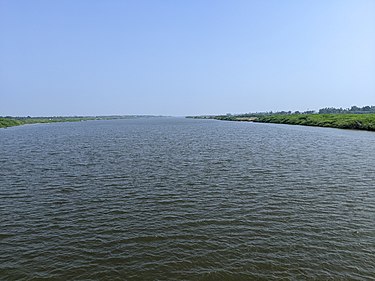- Thiruarimeya Vinnagaram or Kudamudakoothan Perumal Temple is dedicated to Hindu god Vishnu located in Thirunangur, a village in the outskirts of Sirkazhi in the South Indian state of Tamil Nadu.
- This Temple is also Known as Arimeya Vinnagaram, Kuda Maadu Koothan.
- It is one of the 108 Divyadesam dedicated to Vishnu, who is worshipped as Kudamudakoothan and his consort Lakshmi as Amirtagadavalli.
- Constructed in the Dravidian style of architecture, the temple is glorified in the Divya Prabandha, the early mediaeval Tamil canon of the Azhwar saints from the 6th–9th centuries AD.
- "Ari" means one who makes the sin's to vanish. As the Lord of this place Vanishes our sins, this place is called as Arimeya Vinnagaram.
- Lord Shiva is well known for his dances. Lord Vishnu too gains the name as a good dancer by performing the "Kuda Koothu" dance and got his name as Kuda Maadu Koothan.
PURANIC SIGNIFICANCE 1:
- The Lord Kuda Maadu Koothan gave his graceful darshan to Uthang Maharishi.
- Uthanga Maharishi was the son of Uthunga Maharishi and Gunavathi got married to Prabhai.
- Once a Crocodile took her away when both were taking holy bath in river Ganges.
- Uthanga Maharishi got vexed and roamed in many places and finally came to Thiru Arimeya Vinnagaram.
- There Kuda Maadu Koothan gave darshan to him and said that his wife has attained Mukti (eternity) and got him out of his sorrow.
PURANIC SIGNIFICANCE 2:
- Sage Udhangar was the disciple of Sage Vaidhar and learnt the Vedas from him.
- After the Gurukula, he wanted to offer Guru dakshina. Wife of Guru demanded Udhangar to get the earrings of the queen of the land.
- Udhangar went to the queen and begged for her earrings. As she knew the greatness of Guru Vaidhar, she gladly gave her ear rings to the disciple.
- Udhangar was returning to Gurukula.
- He was too hungry and thirsty. He saw a shepherd with his cows and a pot on his head.
- Udhangar asked the shepherd to give the contents of the pot to quench his thirst and anger. The shepherd said that there was nothing but cow dung and its urine which even his Guru once consumed.
- As Guru himself had eaten it, Udhangar left his Kamandalam – a hand bowl which sages carry – with the ear rings and began drinking the content of the pot.
- One Dakshan coming in the way snatched the Kamandalam and ran away.
- Udhangar chased him but the robber hid in a hole there.
- Udhangar sought the help of the shepherd to recover the ear rings from Dakshan.
- He showed a horse-man coming on the way and advised to seek his help.
- The horseman came near the hole and made his horse spit fire.
- Unableto bear the heat, the robber came out and returned the ear rings to the sage. Udhangar thanked the shepherd and the horseman and reached Gurukulam.
- He narrated his experience to Guru Vaidhar. Guru understood with his wisdom eye – Gnana Dhrusti.
- He told the disciple that it was a test to his Guru bhakti.
- The shepherd was Vishnu and the horseman was Indira on Agni the fire. Guru also said that the contents of the pot was but nectar which helped him to bear the heat..
- Udhangar begged the Lord to grant him His darshan.
- Lord Vishnu with His pot granted the darshan as Kudamadu Koothan.
38ff4b.png)

